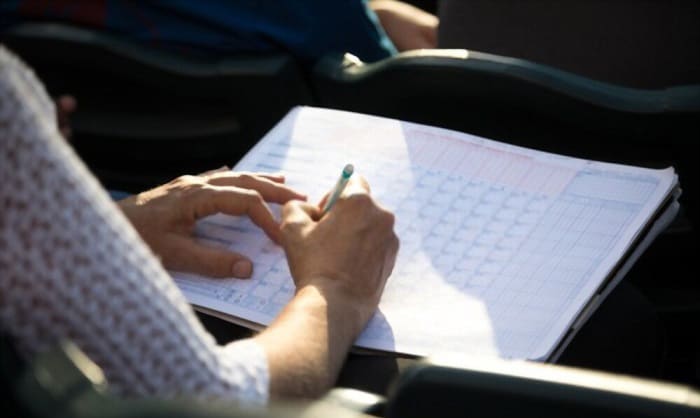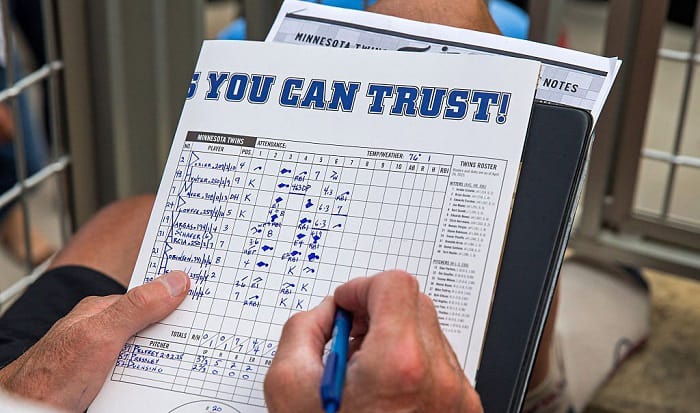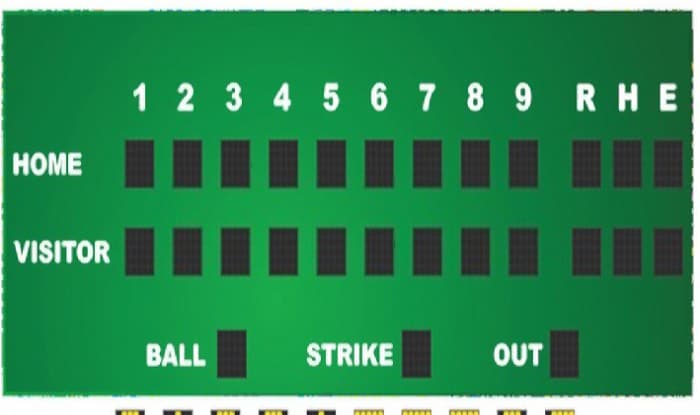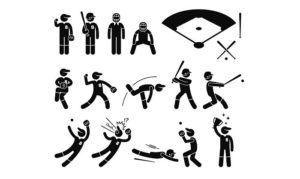Keeping a score in baseball keeps the fans in the loop. The act allows the audience to document and record the development of games, including the number of pitches and player and team performance.
Getting a grasp of a baseball game can be mentally arduous due to the many events in an inning. But the scorecard comes to the rescue.
It contains all the records and can serve as the reference for later calculations.
Read on to learn how to keep score in baseball.
Contents
What to Prepare
1. Scorecard
The official MLB scorecard may come in bulk or as individual pages printed from websites like www.baseballscorecard.com.
You can also directly buy scorecards online.
In simple terms, a scorecard is a sheet printed with scoring templates, cells, and variables.
It allows viewers of the game to make their record of the events per inning.
2. Pencil with Eraser
The pencil allows you to leave marks and erase your writing when keeping score in baseball. When buying a pencil, consider the one with an eraser on its tip.
3. Calculator
The calculator should come in handy when finalizing the scores. Any calculator, as long as it is in the right condition, would do in this case.
4. GoPro Camera (Optional):
Although the GoPro camera may not be as vital as a scoring sheet, it nevertheless helps in recording rapid motions that possibly escaped your sight.
The GoPro camera can serve as your reference when you have to go back later to look into specific scenarios in the game.
Look for the recommended GoPro HERO8 4K model when buying a GoPro camera.
Step by Step Guide
Here is the step by step guide to scoring a baseball game:
Step 1: Prepare your tools and card.
Before you enter the ballpark, check if you have the necessary items in your hand – a scorecard, a pencil with an eraser, and a camera (if you want).
With your tools ready, make sure to set your baseball scoring sheet for action.
Here’s how to do it:
- Write the two teams’ batting lineup on the left corner of the sheet or scorecard. List the lineups right under the “players” or “batters” category.
- You should also list the players’ positions and numbers for later reference.
Step 2: Memorize several signals and positions in the game.
Scoring baseball games would be impossible without the signals, figures, and abbreviations.
When handling or using baseball scoring cards, make sure to, first and foremost, familiarize yourself with the player positions in baseball, as well as their assigned numbers.
For example:
- The pitcher position is number one.
- A catcher is number two.
- The first baseman is number three
- A second baseman is number four.
- A third baseman is number five.
- A shortstop is number six.
- A left-fielder is number seven.
- A center-fielder is number eight.
- The right-fielder position is number nine.
- A designated hitter is written as DH.
Now, when looking at scoring for a baseball game, note down the pitcher-batter dynamics by using shorthand. Use a GoPro camera for reviewing fast actions when necessary.
Here are short-hand terms for keeping track of batter performance:
- BB for Base on balls (or walks)
- SAC or SH for Sacrifice hit
- HR for Homerun
- DP for Double Play
- 1B for Single
- 2B for Double
- F for Flyout
- WP for Wild Pitch
- BK for Balk
- 3B for Triple
- K for Strikeout
- Backwards K for a Third Strike Call without the batter making a swing
Step 3: Do the scoring!
Although scoring approaches may vary from one fan to another, the basics in score keeping share some similarities.
Here are some standards for scorekeeping:
- 6-3: This scoring figure entails that the shortstop was able to throw out the hitter at first base.
- 7: This figure means that a hitter does a flyout towards the left field.
- Hit: This indicates that the batter gets hit and reaches a base. Mark the base, represented by any of the boxes.
- “-” in lower right corner: This indicates that the batter reaches first base and hits a ball simultaneously without being put out.
- “=” on the upper right corner: This scoring figure says that the batter hits the ball and reaches second base simultaneously without having to bring out a baserunner.
- BB on the lower right: This figure indicates that the pitcher walked.
- Circle below the box: This symbol indicates that the runner scored.
Finally, at the end of the inning, add all the runs and hits to come up with inning points. Do this for each inning and finalize the score for the whole game.
Additional tip:
You can always customize your scorecard or scorekeeping system. As stated above, there is no one scoring system for all fans.
Our baseball score sheet example further emphasizes that everyone should first master the terms needed to keep track of the game and its dynamics.
It’s possible to establish a scoring system and memorize the abbreviations correctly with a bit of effort.
Conclusion
Learning how to keep score in baseball makes you an expert in the game and helps you enjoy the game even more.
Scorekeeping in baseball can be pretty fun and challenging at the same time. To do it properly, one must have the right tools, such as a scorecard, a pencil with an eraser, and even a GoPro camera.
A scorekeeper is also required to master the game’s signals, codes, and positions.
Lastly, always remember that you can adjust your scoring system overtime.

A powerful swing and the ball is flying across the field, just one hit, and we might never forget the thrill it brings. I do not know about you, but I never do. Every baseball game is the chance to compete with others and cooperate with your teammate. It is among my biggest passions.
















